Permaculture companion plants for Nasturtium
| Image | Name | Data | Description | Actions |
|---|---|---|---|---|
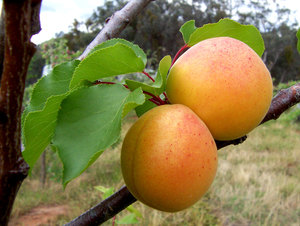
|
Apricot |
4-8
Perennial
Full sun, Partial sun/shade
Moist
Light (sandy), Medium
Deciduous
9.0
Trees
Adhesive, Dye, Gum, oil, Lumber, Espalier
true
Fruit, Seed
https://en.wikipedia.org/wiki/Prunus_armeniaca
Medium
Rosaceae
true
Oil, Gum
https://pfaf.org/User/Plant.aspx?LatinName=Prunus armeniaca
China North-Central, China South-Central, Inner Mongolia, Kazakhstan, Kirgizstan, Kriti, Manchuria, Qinghai, Uzbekistan, Xinjiang
Afghanistan, Albania, Algeria, Bulgaria, California, Central European Rus, Colorado, Corse, Cyprus, East European Russia, East Himalaya, France, Germany, Greece, Hungary, Idaho, Illinois, Iowa, Iran, Italy, Kansas, Korea, Krym, Lebanon-Syria, Libya, Michigan, Missouri, Montana, Morocco, New Mexico, New South Wales, North Caucasus, Oregon, Pakistan, Pennsylvania, Portugal, Queensland, Romania, Sardegna, South Australia, South European Russi, Tadzhikistan, Transcaucasus, Tunisia, Turkey, Turkey-in-Europe, Turkmenistan, Ukraine, Utah, Virginia, Washington, West Himalaya, Yugoslavia
https://powo.science.kew.org/taxon/urn:lsid:ipni.org:names:729463-1
|
The apricot is a tree native to China and Central Asia. It typically grows to be about 20-30 feet tall and has a spreading, round canopy. The leaves are oval-shaped and about 2-4 inches long, with a serrated edge and a glossy green surface. The flowers are white or pink and have five petals. The fruit is a drupe, similar in appearance to a peach, with a smooth, orange skin and a fleshy interior. Apricots are known for their sweet flavor and are often used in jams, jellies, and other preserves. The fruit can also be eaten fresh or dried. The seed, or pit, of the apricot contains a small amount of cyanide and should not be eaten. Apricots prefer a warm, sunny climate and well-draining soil. They are sensitive to frost and can be damaged by cold temperatures. To successfully grow apricots, they should be planted in an area with full sun exposure and watered regularly. Apricots have a number of uses beyond their delicious fruit. The wood of the tree is often used for smoking meats, and the leaves can be used as a natural insecticide. In traditional medicine, apricot oil has been used to treat a variety of ailments. |
Show
Edit |

|
Sweet cherry |
3-7
Perennial
Full sun, Partial sun/shade
Moist
Light (sandy), Medium, Heavy (clay)
Deciduous
18.0
Trees
Dye, Gum, Tannin, Lumber, Espalier
true
Fruit, Seed
https://en.wikipedia.org/wiki/Prunus_avium
Fast
Sweet cherry
Rosaceae
Süßkirsche
https://pfaf.org/User/Plant.aspx?LatinName=Prunus avium
183
Afghanistan, Albania, Algeria, Austria, Belarus, Belgium, Bulgaria, Corse, Cyprus, Czechoslovakia, Denmark, France, Germany, Great Britain, Greece, Hungary, Iran, Ireland, Italy, Krym, Libya, Morocco, Netherlands, North Caucasus, Norway, Poland, Portugal, Romania, Sardegna, Sicilia, Spain, Sweden, Switzerland, Transcaucasus, Tunisia, Turkey, Turkey-in-Europe, Ukraine, Yugoslavia
Arizona, Baleares, Baltic States, British Columbia, California, Central European Rus, Connecticut, Delaware, District of Columbia, East European Russia, East Himalaya, Finland, Idaho, Illinois, Indiana, Kazakhstan, Kentucky, Korea, Maine, Maryland, Massachusetts, Michigan, New Brunswick, New Hampshire, New Jersey, New Mexico, New South Wales, New York, New Zealand North, New Zealand South, North Carolina, Nova Scotia, Ohio, Ontario, Oregon, Pakistan, Pennsylvania, Rhode I., South Australia, South Carolina, South European Russi, Tadzhikistan, Tennessee, Turkmenistan, Utah, Victoria, Virginia, Washington, West Himalaya, West Virginia, Wyoming
3
https://powo.science.kew.org/taxon/urn:lsid:ipni.org:names:30093848-2
Gum
|
The sweet cherry, Prunus avium, is a fruit-bearing tree that is native to Europe, western Asia, and northern Africa. It typically grows to a height of 15-30 feet, with a spread of 20-25 feet, and has a rounded crown. The leaves are oblong-shaped, with serrated edges and a glossy dark green color. The flowers are white or pale pink, with five petals, and appear in clusters in the spring before the leaves. The fruit, which is the sweet cherry, is a small, round drupe, with a smooth, dark red or black skin and a juicy, sweet flesh. In terms of growing conditions, the sweet cherry prefers well-drained, fertile soil and full sun exposure. It can be grown in a variety of climates, but may require protection from frost in harsh climates. To cultivate the sweet cherry successfully, a grower may need to prune the tree to maintain its shape, provide adequate water and fertilizer, and protect the tree from pests and diseases. The sweet cherry is edible and can be eaten fresh or used in a variety of culinary dishes. The fruit can be stored in the refrigerator for a few days or preserved by freezing or canning. The sweet cherry is also valued for its medicinal properties, as the fruit and leaves have been used in traditional medicine to treat a variety of ailments. In terms of its value for wildlife, the sweet cherry provides food for a variety of animals, including birds, squirrels, and other small mammals. It also provides shelter and habitat for these animals. |
Show
Edit |
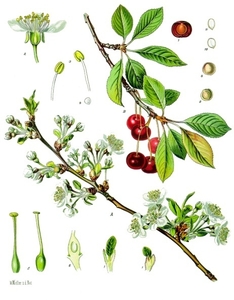
|
Sour cherry |
https://en.wikipedia.org/wiki/Prunus_cerasus
true
Moist
Full sun, Partial sun/shade
3-7
Trees
Light (sandy), Medium, Heavy (clay)
Rosaceae
6.0
Sauerkirsche
Oil, Gum, Tea
Fruit, Seed
Adhesive, Dye, Gum, Hedgerow, oil, Lumber
Perennial
Deciduous
https://pfaf.org/User/Plant.aspx?LatinName=Prunus cerasus
North Caucasus
Afghanistan, Alaska, Argentina South, Austria, Baltic States, Belgium, British Columbia, Bulgaria, California, Central European Rus, Connecticut, Czechoslovakia, Delaware, District of Columbia, East European Russia, East Himalaya, France, Georgia, Germany, Great Britain, Hungary, Idaho, Illinois, Indiana, Iowa, Iran, Ireland, Irkutsk, Italy, Kansas, Kazakhstan, Kentucky, Korea, Madeira, Maine, Maryland, Massachusetts, Michigan, Missouri, Montana, Nebraska, New Brunswick, New Hampshire, New Jersey, New Mexico, New South Wales, New York, New Zealand North, New Zealand South, North Carolina, Nova Scotia, Ohio, Ontario, Oregon, Pakistan, Pennsylvania, Poland, Portugal, Prince Edward I., Québec, Rhode I., Sardegna, Sicilia, South European Russi, Spain, Sweden, Switzerland, Tadzhikistan, Transcaucasus, Turkey, Turkmenistan, Ukraine, Uzbekistan, Vermont, Virginia, Washington, West Himalaya, West Siberia, West Virginia, Xinjiang, Yugoslavia
https://powo.science.kew.org/taxon/urn:lsid:ipni.org:names:729574-1
|
Show
Edit |
|
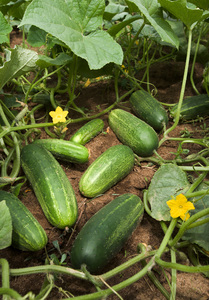
|
Cucumis sativus |
9-11
Annual
Full sun
Moist
Light (sandy), Medium, Heavy (clay)
2
Vines
Fruit, Leaves, Seed
Seed - direct sow, Seed - transplant
1 week after last frost
https://en.wikipedia.org/wiki/Cucumber
Cucurbitaceae
Gurke
50-65
23cm
6.0-6.8
15-30°C (60-85°F)
https://pfaf.org/User/Plant.aspx?LatinName=Cucumis sativus
True
Fruit
Assam, Bangladesh, China South-Central, China Southeast, East Himalaya, Myanmar, Nepal, Thailand, West Himalaya
Alabama, Albania, Andaman Is., Arizona, Arkansas, Austria, Bahamas, Bolivia, Caroline Is., Cayman Is., Colombia, Costa Rica, Cuba, Czechoslovakia, Denmark, Dominican Republic, Ecuador, Florida, Georgia, Gulf of Guinea Is., Haiti, Illinois, India, Jamaica, Kansas, Kazakhstan, Kentucky, Korea, Laos, Leeward Is., Louisiana, Marianas, Marshall Is., Massachusetts, Michigan, Mississippi, Missouri, New Caledonia, New York, Nicaragua, Nicobar Is., North Carolina, North Caucasus, Ohio, Oman, Ontario, Pakistan, Pennsylvania, Pitcairn Is., Puerto Rico, South Carolina, Sri Lanka, Sweden, Tadzhikistan, Trinidad-Tobago, Turkmenistan, Utah, Uzbekistan, Venezuela, Vietnam, Virginia, Windward Is., Zaïre
2-3 weeks before last frost
1 week after last frost
0.9
https://powo.science.kew.org/taxon/urn:lsid:ipni.org:names:292296-1
Oil
Cosmetic, oil
true
|
Cucumber, scientific name Cucumis sativus, is a member of the gourd family. It is native to India and other parts of Asia. Cucumber is a trailing or climbing plant that grows to a height of 5-10 feet. The leaves are dark green and glossy, and the plant produces yellow flowers. The fruit of the cucumber plant is a long, green, edible vegetable with a thin skin. Cucumbers are typically about 6-9 inches long and 2-3 inches in diameter. In terms of growth and cultivation, cucumber plants prefer warm, sunny conditions and well-draining soil. They should be watered regularly, especially during dry periods. Cucumber plants are not winter hardy and should be grown in the summer months in most climates. To cultivate cucumbers successfully, it is important to provide them with adequate space to grow and to support the plants with trellises or other means to keep the fruits off the ground. The plant will develop male and female flowers. You can recognize the female by having a tiny cucumber underneath. Sometimes the plant develops a lot of male flowers first, so be patient. If you don’t see any bees pollinating. Take a male and put it on all the female flowers. Cucumber fruits are edible and can be eaten raw, pickled, or cooked. The skin and seeds of the cucumber are edible, but some people choose to remove the seeds before eating the fruit. Cucumber fruits can be stored in the refrigerator for a few days after harvest. Cucumbers have several uses. In addition to being eaten as a vegetable, they can also be used in a variety of dishes and salads. Cucumber slices are often used as a garnish or as a refreshing addition to beverages. Cucumbers are also commonly used in natural skin care products and are believed to have anti-inflammatory and soothing properties. #### Propagation Direct sow when soil is warm enough in early summer. Sow seeds individually indoors 3-4 weeks before planting outside into warm soil. Use bottom heat if possible. Transplant when plants develop third leaf. #### Medicinal Fruit is depurative, diuretic, emollient, purgative and resolvent #### Links [Cucumber @ West Coast Seeds](https://www.westcoastseeds.com/products/patio-snacker) |
Show
Edit |

|
Peach |
5-9
Perennial
Full sun
Moist
Light (sandy), Medium, Heavy (clay)
6
Trees
true
Flowers, Fruit, Seed
https://en.wikipedia.org/wiki/Peach
Fast
Flowering peach, ornamental peach, common peach
Rosaceae
Pfirsich, bergpfirsich, tellerpfirsich, saturnpfirsich, weinbergpfirsich
Oil, Gum, Tea
https://pfaf.org/User/Plant.aspx?LatinName=Prunus persica
China North-Central
Afghanistan, Alabama, Argentina Northwest, Arizona, Arkansas, Assam, Baleares, Bulgaria, California, Cape Verde, China South-Central, China Southeast, Colorado, Connecticut, Corse, Cyprus, Delaware, District of Columbia, East European Russia, East Himalaya, Ecuador, El Salvador, Ethiopia, Florida, France, Free State, Georgia, Greece, Hungary, Idaho, Illinois, India, Indiana, Iowa, Iran, Italy, Japan, Kansas, Kazakhstan, Kentucky, Kenya, Kirgizstan, Korea, Kriti, Krym, KwaZulu-Natal, Laos, Libya, Louisiana, Maine, Marianas, Maryland, Massachusetts, Mauritius, Michigan, Mississippi, Missouri, New Jersey, New Mexico, New South Wales, New York, New Zealand North, North Carolina, North Caucasus, Northern Provinces, Nova Scotia, Ohio, Oklahoma, Ontario, Oregon, Pakistan, Pennsylvania, Portugal, Queensland, Rhode I., Rodrigues, Romania, Réunion, Sardegna, South Australia, South Carolina, South European Russi, St.Helena, Switzerland, Tadzhikistan, Tennessee, Texas, Transcaucasus, Turkey, Turkmenistan, Ukraine, Utah, Uzbekistan, Vietnam, Virginia, West Himalaya, West Virginia, Wisconsin
3
https://powo.science.kew.org/taxon/urn:lsid:ipni.org:names:1212858-2
Adhesive, Cleanser, Dye, Gum, oil, Espalier
|
The peach, scientifically known as Prunus persica, is a deciduous tree native to northwest China. It typically grows to be about 10-30 feet tall, with a short trunk and a rounded crown. The leaves are oval-shaped, with serrated edges and a glossy, dark green color. The flowers are pink and white, with five petals each. Peaches are known for their fuzzy, peach-colored skin and juicy, sweet flesh. They can be eaten fresh, canned, or cooked into dishes such as pies and cobblers. The edible parts of the peach include the flesh and the seed, which contains a small kernel that can be ground into flour. Peaches can be stored after harvest by keeping them in a cool, dry place. Peaches prefer well-draining, loamy soil and full sun. They can be grown in a variety of climates, but do best in warm, temperate regions. To cultivate peaches successfully, growers may need to provide support for the trees, prune them regularly, and protect them from pests and diseases. Peaches are generally winter hardy, but can be damaged by frost. In addition to being eaten fresh, peaches have a variety of uses. The flowers can be used in herbal teas, and the leaves can be used to make a yellow dye. The wood of the tree can be used for smoking meat, and the kernels can be used to make oil. Peaches are also a valuable food source for wildlife, attracting birds, squirrels, and other animals. |
Show
Edit |

|
Nectarine |
4-8
Perennial
Full sun
Moist
Light (sandy), Medium, Heavy (clay)
Deciduous
6.0
Trees
Adhesive, Cleanser, Dye, Gum, oil, Espalier
true
Flowers, Fruit, Seed
Rosaceae
Nektarine
Oil, Gum, Tea
https://pfaf.org/User/Plant.aspx?LatinName=Prunus persica nucipersica
Nectarine
Nektarin
3
|
Nectarine (Prunus persica nucipersica) is a plant that is a type of stone fruit. It is native to China and is closely related to the peach. Nectarines are similar in appearance to peaches, but have smooth skin rather than fuzzy skin. They can range in size from small to large and are typically round or oval in shape. Nectarines have green or red leaves and white or pink flowers. The stems of the plant are generally thin and have thorns. Nectarines can grow to be quite large, reaching heights of up to 8 meters. They grow best in warm, sunny climates and well-drained soil. To cultivate nectarines successfully, a grower will need to provide the plant with plenty of sunlight and water. They may also need to prune the plant to maintain its shape and encourage new growth. Nectarines are edible and the fruit can be eaten fresh or cooked. The edible parts of the fruit can be stored in a cool, dry place after harvest. Nectarines have several uses. In addition to being eaten fresh or cooked, they can also be used to make jams, jellies, and other preserves. They can also be dried and used as a snack. In addition to their culinary uses, nectarines have been used medicinally for their high vitamin and mineral content. They are also valued for their ability to attract wildlife, such as birds and bees, to the garden. |
Show
Edit |
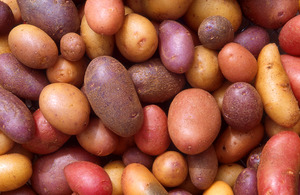
|
Potato |
3-10
Full sun
Moist
Light (sandy), Medium, Heavy (clay)
1.0
0.5
Perennial
12 inches
Seed - direct sow
April
Root
Irish potato, Andigena
Kartoffel
Solanaceae
Argentina Northwest, Argentina South, Bolivia, Chile Central, Chile North, Chile South, Colombia, Ecuador, Peru, Venezuela
Assam, Bangladesh, Belgium, Dominican Republic, East European Russia, East Himalaya, France, Great Britain, Haiti, Hawaii, Illinois, India, Ireland, Laos, Maryland, Minnesota, New York, South European Russi, Tadzhikistan, Uzbekistan, Vietnam, Zaïre
https://en.wikipedia.org/wiki/Potato
https://pfaf.org/User/Plant.aspx?LatinName=Solanum tuberosum
https://powo.science.kew.org/taxon/urn:lsid:ipni.org:names:821337-1
Rutin
Alcohol, Biomass, Cleanser, Cosmetic, Polish, Starch
true
|
Potato (Solanum tuberosum) is a herbaceous perennial plant that is native to the Andean region of South America. It is a member of the nightshade family (Solanaceae) and is closely related to other nightshades such as tomatoes, eggplants, and bell peppers. The potato plant has a bushy growth habit and can grow to heights of 30-150 cm depending on the variety. The leaves are large, heart-shaped, and alternate along the stem. The flowers are white or purple and have five petals. The plant produces small green berries that contain numerous seeds, but most varieties of potatoes are propagated vegetatively from tubers rather than from seeds. The edible part of the potato plant is the tuber, which is an underground stem that is modified for food storage. Potatoes come in a wide range of shapes, sizes, and colors including white, yellow, red, and purple. The size and shape of the tuber depends on the variety, with some varieties producing small, round tubers and others producing large, elongated tubers. Potatoes grow best in well-draining, fertile soils in a sunny location with a pH of 4.5-6.0. They require regular watering and should be planted in a location with good air circulation to prevent fungal diseases. Potatoes are typically planted from tubers that have been treated with a fungicide to prevent disease and are spaced 25-30 cm apart in rows that are 75-90 cm apart. The tubers will begin to form in the soil around 6-8 weeks after planting and can be harvested when they reach the desired size. Potatoes are a versatile and nutritious food source that is rich in vitamins, minerals, and fiber. The tubers are eaten cooked, baked, fried, or mashed, and the leaves and flowers of the plant can also be eaten. Potatoes can be stored in a cool, dry, and dark place for several months. Potatoes have a number of uses beyond their value as a food source. The tubers can be used as seed potatoes for planting, and the leaves and stems can be used as a natural insecticide or as mulch in the garden. In some parts of the world, potatoes are also used for their medicinal properties. Potatoes are a valuable food source for a variety of wildlife, including deer, rabbits, and squirrels. The flowers of the potato plant are also a source of nectar for bees and other pollinators. |
Show
Edit |

|
Raphanus sativus |
2-11
Full sun, Partial sun/shade
Moist
Light (sandy), Medium, Heavy (clay)
0.5
0.3
Annual
Roots
Fast
true
Flowers, Leaves, Root, Seed, Seedpod
Oil
Cultivated radish
Rettich
Brassicaceae or cruciferae
Greece, Italy, Sicilia, Yugoslavia
Alabama, Alaska, Algeria, Altay, Andaman Is., Angola, Argentina Northeast, Argentina Northwest, Argentina South, Arizona, Arkansas, Assam, Baleares, Baltic States, Bangladesh, Belarus, Belgium, Bermuda, Bolivia, Brazil South, Brazil Southeast, British Columbia, Bulgaria, California, Canary Is., Caroline Is., Central European Rus, Chile Central, Chile North, Chile South, China North-Central, China South-Central, China Southeast, Colombia, Colorado, Connecticut, Corse, Costa Rica, Cuba, Cyprus, Delaware, District of Columbia, Dominican Republic, East Aegean Is., East European Russia, East Himalaya, Ecuador, Egypt, El Salvador, Eritrea, Ethiopia, Fiji, Florida, Galápagos, Georgia, Gilbert Is., Guatemala, Gulf of Guinea Is., Gulf States, Hainan, Haiti, Hawaii, Idaho, Illinois, India, Indiana, Inner Mongolia, Iowa, Iraq, Japan, Jawa, Kansas, Kazakhstan, Kazan-retto, Kenya, Korea, Kriti, Krym, Kuwait, Labrador, Lebanon-Syria, Leeward Is., Libya, Louisiana, Madeira, Maine, Manchuria, Manitoba, Marianas, Marshall Is., Maryland, Massachusetts, Mauritania, Mexican Pacific Is., Mexico Northwest, Michigan, Minnesota, Mississippi, Missouri, Montana, Morocco, Nansei-shoto, Nebraska, Nepal, Nevada, New Brunswick, New Caledonia, New Hampshire, New Jersey, New Mexico, New South Wales, New York, Newfoundland, Nicobar Is., North Carolina, North Dakota, North European Russi, Northern Provinces, Nova Scotia, Ohio, Oklahoma, Oman, Ontario, Oregon, Pakistan, Palestine, Paraguay, Pennsylvania, Portugal, Primorye, Prince Edward I., Puerto Rico, Qinghai, Queensland, Québec, Rhode I., Rwanda, Sardegna, Saskatchewan, Saudi Arabia, South Australia, South Carolina, South Dakota, South European Russi, Spain, Sri Lanka, Sudan, Sumatera, Switzerland, Tadzhikistan, Tanzania, Tasmania, Texas, Tibet, Tunisia, Turkey, Turkey-in-Europe, Turkmenistan, Ukraine, Uruguay, Utah, Uzbekistan, Victoria, Vietnam, Virginia, Wake I., Washington, West Himalaya, West Virginia, Western Australia, Windward Is., Wisconsin, Wyoming, Xinjiang, Yemen, Zimbabwe
https://en.wikipedia.org/wiki/Radish
https://pfaf.org/User/Plant.aspx?LatinName=Raphanus sativus
https://powo.science.kew.org/taxon/urn:lsid:ipni.org:names:77159305-1
Weed potential
Animal feed, Cover crop, oil
|
The radish, also known as Raphanus sativus, is a plant native to southwestern Asia and the eastern Mediterranean region. It is a cool-season annual that grows quickly, often maturing in just a few weeks. The radish has a distinctive round or oblong shape, with a crisp and juicy texture. Its skin is typically red or white, but can also be purple, yellow, or black. The leaves of the radish are elongated and dark green in color, while its flowers are small and white or yellow in color. Radishes are relatively small, typically growing to be about four inches long and two inches wide. They prefer well-drained soil that is high in organic matter, and can be grown in a variety of climates, including temperate and subtropical regions. Radishes are typically differentiated from similar plants, such as turnips, by their smaller size and more pungent flavor. They can be harvested at any stage of their growth, but are typically harvested when they are young and tender for the best flavor. To cultivate radishes successfully, a grower will need to plant them in well-prepared soil, water them regularly, and thin out the plants to prevent overcrowding. Radishes are generally hardy and can tolerate frost, making them a good choice for a fall or winter garden. The edible parts of the radish plant are the root and the leaves. The root can be eaten raw, cooked, or pickled, while the leaves can be used in salads or cooked like other leafy greens. After harvest, the roots can be stored in a cool and dark place, such as a root cellar, to prolong their shelf life. Radishes have a number of uses, both in the garden and beyond. In the garden, they can be used as a companion plant to deter pests and improve the health of other plants. In addition to their use in cooking, radishes have also been used medicinally, with some evidence suggesting that they may have anti-inflammatory and digestive health benefits. Radishes are also a valuable food source for wildlife, providing a source of nutrition for birds and small mammals. They are a popular food for bees and other pollinators, and can help to attract these beneficial insects to the garden. |
Show
Edit |

|
Rose |
2
Perennial
Full sun, Partial sun/shade
Deciduous
Shrubs
Animal feed, Attracts insects, Hedgerow, Wind breaker, Wildlife habitat
True
Fruit
Rosaceae
Zambia
https://powo.science.kew.org/taxon/urn:lsid:ipni.org:names:77120313-1
1
|
Show
Edit |
|
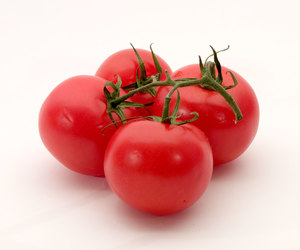
|
Tomato |
10-12
Annual, Perennial
Full sun
Moist
Light (sandy), Medium, Heavy (clay)
2.0
True
Fruit, Seed
https://en.wikipedia.org/wiki/Tomato
Fast
Garden tomato, Dumádu, Garden tomato, Love apple, Lycopersicum esculentum, Tomate, Tomato, Tomato extract containing lycopene, Tomato|thakkali, Tumatis, Lycopersicon esculentum
Solanaceae
Tomate
Oil
https://pfaf.org/User/Plant.aspx?LatinName=Solanum lycopersicum, https://pfaf.org/User/Plant.aspx?LatinName=Lycopersicon esculentum
Start seeds indoors 5-6 weeks before last frost
In containers or in rows in beds around last frost date
6.2-6.8
70-80°f
Peru
Alabama, Alaska, Andaman Is., Angola, Arizona, Arkansas, Assam, Austria, Azores, Bahamas, Bangladesh, Belarus, Benin, Bolivia, British Columbia, Bulgaria, Burkina, California, Cambodia, Cameroon, Canary Is., Cape Verde, Caroline Is., Central African Repu, Chagos Archipelago, Chatham Is., Christmas I., Colombia, Comoros, Connecticut, Cook Is., Costa Rica, Cuba, Cyprus, Czechoslovakia, Delaware, Dominican Republic, East Aegean Is., East European Russia, East Himalaya, Ecuador, Fiji, Florida, Galápagos, Georgia, Gilbert Is., Gulf of Guinea Is., Haiti, Hawaii, Illinois, India, Indiana, Iowa, Ivory Coast, Jawa, Kansas, Kazakhstan, Kentucky, Korea, Laccadive Is., Laos, Leeward Is., Line Is., Louisiana, Madagascar, Madeira, Maine, Malawi, Mali, Marianas, Marquesas, Marshall Is., Maryland, Massachusetts, Mauritania, Mauritius, Michigan, Mississippi, Missouri, Montana, Mozambique, Myanmar, Namibia, Nansei-shoto, Nauru, Nebraska, Nepal, Nevada, New Brunswick, New Caledonia, New Hampshire, New York, New Zealand North, Nicaragua, Nicobar Is., Niue, North Carolina, North Dakota, Nova Scotia, Ogasawara-shoto, Ohio, Ontario, Oregon, Pakistan, Panamá, Pennsylvania, Philippines, Pitcairn Is., Puerto Rico, Québec, Rhode I., Réunion, Saskatchewan, Selvagens, Society Is., South Carolina, South European Russi, Tadzhikistan, Taiwan, Tennessee, Texas, Trinidad-Tobago, Tuamotu, Tubuai Is., Turkey, Turkmenistan, Tuvalu, Utah, Uzbekistan, Venezuela, Vermont, Vietnam, Virginia, Wake I., Wisconsin, Zambia, Zaïre, Zimbabwe
1.00
https://powo.science.kew.org/taxon/urn:lsid:ipni.org:names:316947-2
|
The tomato is a flowering plant native to South America. It is a member of the nightshade family and closely related to the potato. The tomato plant typically grows to a height of 1-3 meters and has a weak, hairy stem. The leaves are arranged alternately on the stem and are typically dark green in color. The plant produces small yellow or white flowers, which develop into the fruit we know as tomatoes. The fruit itself is typically red, but can also be yellow, orange, green, or purple. Indeterminate tomato plants are perennials in their native habitat, but are cultivated as annuals. Determinate, or bush, plants are annuals that stop growing at a certain height and produce a crop all at once. Tomatoes prefer warm, sunny growing conditions and well-drained, humus-rich soil. They can be grown in a variety of soil types, but perform best in soil with a pH between 6 and 6.8. In order to cultivate tomatoes successfully, growers may need to provide support for the plant (such as a stake or cage) to prevent the fruit from weighing down the stem, and may also need to water and fertilize the plant regularly. Tomatoes are generally considered to be frost-sensitive, so in areas with cold winters they may need to be grown in a greenhouse or indoors. There are a great number of cultivars. The edible parts of the tomato plant are the fruit and the leaves. The fruit can be eaten raw or cooked, and is commonly used in a variety of dishes, such as salads, sandwiches, and pasta. The leaves, although not commonly eaten, are also edible and have a slightly bitter taste. After harvest, tomatoes can be stored at room temperature, in a cool place, or in the refrigerator. |
Show
Edit |

|
Pumpkin / Zucchini |
2-11
Annual
Full sun, Partial sun/shade
Moist
Light (sandy), Medium, Heavy (clay)
0.6
Vines
true
Flowers, Fruit, Leaves, Root, Seed
https://en.wikipedia.org/wiki/Cucurbita_pepo
Fast
Courgette, field pumpkin, ozark melon, texas gourd
Cucurbitaceae
Oil
https://pfaf.org/User/Plant.aspx?LatinName=Cucurbita pepo
Mexico Central, Mexico Gulf, Mexico Northeast, Mexico Northwest, Mexico Southeast, Mexico Southwest
Alabama, Albania, Argentina Northeast, Argentina Northwest, Arkansas, Assam, Azores, Bahamas, Bangladesh, Belgium, Benin, Bolivia, Brazil South, Burkina, California, Cameroon, Cape Verde, Caroline Is., Cayman Is., China South-Central, China Southeast, Connecticut, Cook Is., Costa Rica, Cuba, Czechoslovakia, Denmark, Dominican Republic, East Himalaya, Finland, France, Gambia, Gilbert Is., Greece, Guatemala, Haiti, Illinois, India, Italy, Kansas, Kazakhstan, Kentucky, Korea, Louisiana, Marianas, Marshall Is., Massachusetts, Michigan, Nauru, Nevada, New Caledonia, New Hampshire, New Mexico, New York, New Zealand North, New Zealand South, Nigeria, North Carolina, Norway, Ohio, Oman, Ontario, Pennsylvania, Puerto Rico, Québec, Sierra Leone, South Carolina, St.Helena, Sweden, Tadzhikistan, Tennessee, Texas, Tokelau-Manihiki, Trinidad-Tobago, Turkey, Turkmenistan, Tuvalu, Utah, Uzbekistan, Venezuela, Venezuelan Antilles, Vermont, Vietnam, Virginia, Wake I., West Himalaya, Zaïre
1
https://powo.science.kew.org/taxon/urn:lsid:ipni.org:names:292416-1
oil
|
Cucurbita pepo is a species of plant native to North America. It contains many varieties of squash and is commonly grown by gardeners and farmers. The plant has large, lobed leaves, and a thick stem. The flowers are yellow and the fruit is typically large and round or oval-shaped. The plant can grow to be quite large, with some varieties reaching over 6 feet in height and 10 feet in width. It is fast-growing and can be differentiated from other plants by its large leaves and fruit. Cucurbita pepo prefers well-draining soil and full sunlight. To cultivate it successfully, a grower will need to provide plenty of water and ensure that the soil is warm enough for the seeds to germinate. The plant is not winter hardy and will not survive cold temperatures. Some varieties of Cucurbita pepo are edible, including pumpkins, zucchini, and acorn squash. The edible parts of the plant can be stored after harvest by curing the fruit in a warm, dry place for several weeks. This will help to preserve its flavor and texture. Cucurbita pepo has a variety of uses. The plant is often used as a source of food, both for humans and for animals. The fruit is high in vitamins and minerals and can be cooked in a variety of ways. The seeds can also be eaten, and are high in protein and healthy fats. In addition to its use as a food source, the plant can also be used for medicinal purposes. The leaves and fruit can be used to treat a variety of ailments, including stomach aches and skin irritation. The plant is also valued for its ability to attract wildlife. Bees and other butterflies are attracted to the flowers, and birds and small mammals often eat the fruit. This can help to support local ecosystems and promote biodiversity. |
Show
Edit |

|
Apple |
3-8
Full sun, Partial sun/shade
Moist
Light (sandy), Medium, Heavy (clay)
Deciduous
10.0
9
Perennial
Trees
Animal feed, Attracts insects, Hedgerow
True
Fruit
Oil
Appel
Æble
Rosaceae
Malus
Afghanistan, Kazakhstan, Kirgizstan, Pakistan, Tadzhikistan, Uzbekistan, Xinjiang
Alabama, Alaska, Albania, Argentina Northeast, Argentina South, Arkansas, Azores, Baleares, Baltic States, Belarus, Belgium, British Columbia, Bulgaria, California, Central European Rus, Colorado, Connecticut, Cyprus, Czechoslovakia, Delaware, Denmark, District of Columbia, East European Russia, East Himalaya, Ecuador, Falkland Is., Finland, France, Georgia, Germany, Great Britain, Greece, Hungary, Illinois, Indiana, Iowa, Iraq, Ireland, Italy, Kansas, Kentucky, Korea, Krym, Louisiana, Madeira, Maine, Manitoba, Maryland, Massachusetts, Michigan, Minnesota, Mississippi, Missouri, Montana, Nebraska, Nepal, Netherlands, Nevada, New Brunswick, New Hampshire, New Jersey, New Mexico, New South Wales, New York, Newfoundland, North Carolina, North Caucasus, North Dakota, Norway, Nova Scotia, Ohio, Ontario, Oregon, Pennsylvania, Poland, Prince Edward I., Québec, Rhode I., Romania, South Carolina, South European Russi, Spain, Sweden, Tasmania, Tennessee, Turkmenistan, Ukraine, Utah, Vermont, Victoria, Virginia, West Virginia, Wisconsin, Wyoming, Yugoslavia
https://en.wikipedia.org/wiki/Apple
https://pfaf.org/user/plant.aspx?LatinName=Malus+domestica
https://powo.science.kew.org/taxon/urn:lsid:ipni.org:names:726282-1
Apfel
|
An apple is an edible fruit produced by an apple tree (Malus domestica). Apple trees are cultivated worldwide and are the most widely grown species in the genus Malus. The tree originated in Central Asia, where its wild ancestor, Malus sieversii, is still found today. Apples have been grown for thousands of years in Asia and Europe and were brought to North America by European colonists. Apples have religious and mythological significance in many cultures, including Norse, Greek, and European Christian tradition. Apples grown from seed tend to be very different from those of their parents, and the resultant fruit frequently lacks desired characteristics. Generally, apple cultivars are propagated by clonal grafting onto rootstocks. Apple trees grown without rootstocks tend to be larger and much slower to fruit after planting. Rootstocks are used to control the speed of growth and the size of the resulting tree, allowing for easier harvesting. There are more than 7,500 known cultivars of apples. Different cultivars are bred for various tastes and uses, including cooking, eating raw, and cider production. Trees and fruit are prone to a number of fungal, bacterial, and pest problems, which can be controlled by a number of organic and non-organic means. In 2010, the fruit's genome was sequenced as part of research on disease control and selective breeding in apple production. Worldwide production of apples in 2018 was 86 million tonnes, with China accounting for nearly half of the total. From [Wikipedia](https://en.wikipedia.org/wiki/Apple) |
Show
Edit |

|
Broccoli |
2-11
Full sun, Partial sun/shade
Moist
Light (sandy), Medium, Heavy (clay)
6.0-7.0
0.9
Annual, Biennial
45cm
6-8 weeks before last frost
7-10 days
4°C (40°F)
50-100
3 to 7 years
Companion
true
Flowers, Leaves, Shoots
Brokkoli
Brassicaceae or Cruciferae
https://pfaf.org/User/Plant.aspx?LatinName=Brassica oleracea italica
|
Broccoli is a plant that is native to the Mediterranean region. It is part of the Brassica oleracea family, which also includes other vegetables such as cauliflower and cabbage. Broccoli plants have green, flowering heads that are similar in appearance to cauliflower. The stems are typically thick and can grow to be quite large, depending on the variety of broccoli. The leaves of the plant are typically dark green and are arranged in a spiral pattern along the stem. When it comes to growing conditions, broccoli prefers cool weather and well-draining soil. It is a relatively fast-growing plant, with the flowering heads typically forming in the first year. To cultivate broccoli successfully, a grower will need to make sure the plant gets enough water and sunlight, and provide it with the necessary nutrients through fertilization. In terms of winter hardiness, broccoli is not very frost-tolerant, so it is typically grown as a cool-season crop in areas with mild winters. In terms of edibility, broccoli is a very nutritious vegetable that is packed with vitamins and minerals. The flowering heads and the stems are both edible, and can be cooked in a variety of ways. After harvest, broccoli can be stored in the refrigerator for several days, or frozen for longer-term storage. ### Propagation - Direct sow Sow seeds 7cm apart, thin when seedlings reach 5-7cm in height. ### Propagation - Transplant Start seeds 6-8 weeks before your last frost date, or 2-3 weeks before last frost date. Plant outside when seedlings are 4-6 weeks old, or have 4-5 leaves. #### Links [Broccoli @ Almanac](https://www.almanac.com/plant/broccoli) |
Show
Edit |
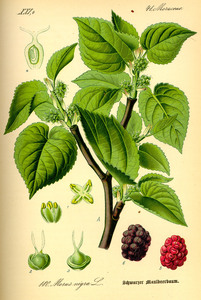
|
Black mulberry |
5-9
Full sun, Partial sun/shade
Moist
Light (sandy), Medium, Heavy (clay)
Deciduous
10.0
4.5
Perennial
Trees
Slow
Dye, Fiber, Lumber
true
Fruit, Shoots
Mulberry, Morus species
Schwarze maulbeere
Moraceae
Iran
Afghanistan, Albania, Algeria, Bermuda, Bulgaria, Canary Is., Cuba, Greece, India, Iraq, Italy, Kazakhstan, Kirgizstan, Kriti, Lebanon-Syria, Leeward Is., Libya, Madeira, Morocco, Puerto Rico, Romania, Spain, Tadzhikistan, Transcaucasus, Tunisia, Turkey, Turkmenistan, Uzbekistan, Vietnam, West Himalaya, Windward Is., Xinjiang
https://en.wikipedia.org/wiki/Morus_nigra
https://pfaf.org/User/Plant.aspx?LatinName=Morus nigra
https://powo.science.kew.org/taxon/urn:lsid:ipni.org:names:854688-1
|
The black mulberry (Morus nigra) is a species of mulberry native to southwestern Asia, including Iran, Afghanistan, and Pakistan. It is a small to medium-sized tree that grows to be about 20-30 feet tall and has a round, dense canopy. The leaves of the black mulberry are dark green and glossy on the top, and paler and slightly hairy on the bottom. The tree produces small, white flowers in the spring, which are followed by black, juicy fruits in the summer. The black mulberry is relatively fast-growing and can reach its full size in about 10-15 years. It prefers well-drained, fertile soil and full sun, but can tolerate partial shade. It is also winter hardy and can withstand temperatures down to about -10°F. The fruits of the black mulberry are edible and can be eaten fresh or used in jams, jellies, and other preserves. They can also be dried and stored for later use. The leaves of the black mulberry can be fed to silkworms, and the wood of the tree is strong and durable, making it suitable for a variety of uses. In addition to its edible fruits, the black mulberry has several other uses. Its leaves can be used as a natural fertilizer, and the tree can provide shade and wind protection in gardens and farms. The black mulberry is also a popular food source for birds and other wildlife. |
Show
Edit |
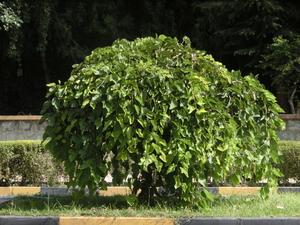
|
White mulberry |
3-9
Full sun, Partial sun/shade
Moist
Light (sandy), Medium, Heavy (clay)
Deciduous
18
13
Perennial
Trees
Medium
Biomass, Dye, Fiber, Animal feed, Wind breaker, Tannin, Lumber
true
Fruit, Inner bark, Leaves, Shoots
Common mulberry
Weiße Maulbeere
Moraceae
Angola, Benin, Cameroon, Central African Repu, Congo, Equatorial Guinea, Gabon, Ghana, Guinea, Guinea-Bissau, Ivory Coast, Kenya, Liberia, Mauritania, Namibia, Nigeria, Senegal, Sierra Leone, Tanzania, Uganda, Zaïre
https://en.wikipedia.org/wiki/Morus_alba
https://pfaf.org/User/Plant.aspx?LatinName=Morus alba
https://powo.science.kew.org/taxon/urn:lsid:ipni.org:names:547653-1
Weed potential
Manna, Tea
|
The white mulberry is a deciduous tree native to northern China, Korea, and Japan. It has large, heart-shaped leaves and small, white or pale pink flowers that grow in clusters. The tree can grow to be quite large, up to 50 feet tall, and it is fast-growing. White mulberry trees can be differentiated from other mulberry trees by their white, rather than dark purple, fruit. White mulberry trees prefer well-draining soil and full sun, but can tolerate partial shade. They are drought-tolerant and can thrive in a variety of soil types. In colder climates, they may need to be protected from frost during the winter months. The fruit of the white mulberry tree is edible and is often used to make jams, jellies, and wines. The fruit can be stored by freezing or canning. Young leaves can also be eaten. White mulberry trees are valued for their fast growth and ability to provide shade. They can be used for wind protection and as a ground cover. The leaves of the tree are sometimes used as animal feed. In some cultures, the bark of the white mulberry tree is used medicinally. Leaves are not frost resistant. |
Show
Edit |
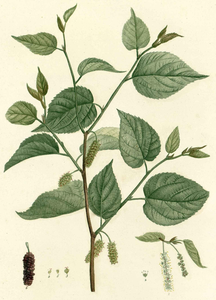
|
Red mulberry |
4-9
Full sun, Partial sun/shade
Moist
Light (sandy), Medium, Heavy (clay)
15.0
4.5
Perennial
Trees
true
Fruit, Leaves, Shoots
Common mulberry, white mulberry
Rote maulbeere
Moraceae
Alabama, Arkansas, Connecticut, District of Columbia, Florida, Georgia, Illinois, Indiana, Iowa, Kansas, Kentucky, Louisiana, Maryland, Massachusetts, Michigan, Minnesota, Mississippi, Missouri, Nebraska, New Jersey, New York, North Carolina, Ohio, Oklahoma, Ontario, Pennsylvania, Rhode I., South Carolina, Tennessee, Texas, Vermont, Virginia, West Virginia, Wisconsin
Bermuda, New Mexico, Turkey, Turkey-in-Europe
https://en.wikipedia.org/wiki/Morus_rubra
https://pfaf.org/User/Plant.aspx?LatinName=Morus rubra
https://powo.science.kew.org/taxon/urn:lsid:ipni.org:names:854710-1
1.5
Fiber, Lumber
|
The Red mulberry, Morus rubra, is native to the eastern United States and Canada. It is a deciduous tree that can grow to a height of up to 80 feet. The leaves are dark green and have a rough texture. The tree produces small, greenish-white flowers in the spring, which develop into clusters of red berries in the summer. The Red mulberry is often differentiated from other mulberry species by its smaller leaves and red berries. It prefers well-drained, moist soil and partial to full sun exposure. It is winter hardy and does not require any special care or maintenance. The fruit of the Red mulberry is edible and can be eaten fresh or used in cooking and baking. The berries can be stored in the refrigerator for up to a week. The tree also has a number of medicinal uses, including as a laxative and for treating sore throat and bronchitis. In terms of wildlife, the Red mulberry is a valuable food source for a variety of birds and mammals. Its fruit is a popular food source for birds such as robins, mockingbirds, and blue jays. The tree also provides habitat for birds and small mammals. |
Show
Edit |